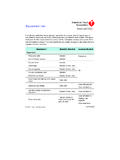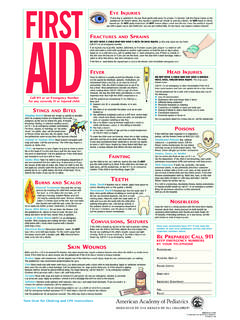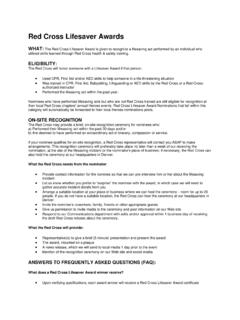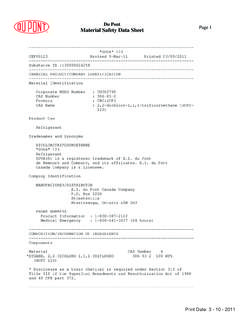Transcription of DEFIBRILLATION - AHA ACLS, BLS, PALS and NRP …
1 DEFIBRILLATION The Pediatric Task Force evaluated several issues related to DEFIBRILLATION , including safe and effective energy dosing, stacked versus single shocks, use of automated external defibrillators (AEDs) in infants <1 year of age and paddle/pad type, size, and position. There were a few new human and animal studies on these topics, and the level of evidence (LOE) was generally 3 to 5. No new data are available to support a change in drug treatment of recurrent or refractory VF/pulseless VT.
2 There were several human and animal publications on DEFIBRILLATION energy dose, but the data are contradictory and the optimal safe and effective energy dose remains unknown. The new recommendation of an initial dose of 2 to 4 J/kg is based on cohort studies showing low success in termination of VF in children with 2 J/kg. However, these studies do not provide data on success or safety of higher energy doses. The reaffirmation of the recommendation for a single initial shock rather than stacked shocks (first made in 2005) is extrapolated from the ever-increasing adult data showing that long pauses in chest compressions required for stacked shocks are associated with worse resuscitation outcomes and that the initial shock success rate is relatively high with biphasic DEFIBRILLATION .
3 No changes are recommended in pad/paddle size or position. Although the safety of AEDs in infants <1 year is unknown, case reports have documented successful DEFIBRILLATION using AEDs in infants. A manual defibrillator or an AED with pediatric attenuation capabilities is preferred for use in infants and small children. Paddle Size and OrientationPeds-029 Consensus on Science One LOE 5 study in adults255 demonstrated that shock success increased from 31% to 82% when pad size was increased from 8 8 cm to 12 12 cm. Three pediatric LOE 4,256, ,258 3 adult LOE 5,255,259,260 and 3 LOE 5 animal261, ,263 studies demonstrated that transthoracic impedance decreases with increasing pad size.
4 Decreased transthoracic impedance increases transthoracic current and, thus, presumably, transmyocardial current. Pad Position Consensus on Science One pediatric LOE 4 study264 observed no difference in the rate of ROSC between antero-lateral and anterior-posterior electrode positions for shock delivery. One pediatric LOE 2 study,256 2 adult LOE 5 studies,265,266 and 1 LOE 5 animal study263 demonstrated that transthoracic impedance is not dependent on pad position. Transthoracic impedance was increased in 1 adult LOE 5267 study by placing the pads too close together and in 1 LOE 5260 study when the pads were placed over the female breast.
5 Additionally, 1 adult LOE 5268 study showed that placing the apical pad in a horizontal position lowers transthoracic impedance. Treatment Recommendation There is insufficient evidence to alter the current recommendations to use the largest size paddles/pads that fit on the infant or child's chest without touching each other or to recommend one paddle/pad position or type over another. Self-Adhesive Pads Versus PaddlesPeds-043A,Peds-043B Consensus on Science There are limited studies comparing self-adhesive DEFIBRILLATION pads (SADPs) with paddles in pediatric cardiac arrest.
6 One pediatric LOE 4264 study demonstrated equivalent ROSC rates when paddles or SADPs were used. One LOE 5269 adult out-of-hospital cardiac arrest study suggested improved survival to hospital admission when SADPs rather than paddles were used. One adult LOE 5270 study showed a lower rate of rhythm conversion, and 1 small adult LOE 5271 study showed at least equivalent success with the use of SADPs in comparison with paddles in patients undergoing cardioversion for atrial fibrillation. Two adult LOE 5272,273 studies showed equivalent transthoracic impedance with SADPs or paddles.
7 One adult LOE 5266 and 2 LOE 5 animal274,275 studies showed that SADPs had a higher transthoracic impedance than paddles. One LOE 4276 study described difficulty with fitting self-adhesive pads onto the thorax of a premature infant without the pads touching. One LOE 5277 study demonstrated the improved accuracy of cardiac rhythm monitoring following DEFIBRILLATION using SADPs compared with the combination of paddles and gel pads. Using standard resuscitation protocols in simulated clinical environments, 1 LOE 5278 study found no significant difference in the time required to deliver shocks using either SADPs or paddles, and 1 LOE 5279 study found no significant difference in time without compressions when SADPs or paddles were used.
8 Treatment Recommendations Either self-adhesive DEFIBRILLATION pads or paddles may be used in infants and children in cardiac arrest. Knowledge Gaps Is the use of hands-on DEFIBRILLATION safe for rescuers and does it improve outcome for infants and children in cardiac arrest (eg, by presumably reducing interruptions in chest compressions)? Number of ShocksPeds-022A Consensus on Science There are no randomized controlled studies examining a single versus sequential (stacked) shock strategy in children with VF/pulseless VT.
9 Evidence from 7 LOE 5 studies in adults with VF221,280, ,285 supported a single-shock strategy over stacked or sequential shocks because the relative efficacy of a single biphasic shock is high and the delivery of a single shock reduces duration of interruptions in chest compressions. Treatment Recommendations A single-shock strategy followed by immediate CPR (beginning with chest compressions) is recommended for children with out-of-hospital or in-hospital VF/pulseless VT. Knowledge Gaps Are there circumstances during which the use of stacked or multiple shocks can improve outcome from pediatric cardiac arrest?
10 Energy DosePeds-023A,Peds-023B Consensus on Science Two LOE 4264,286 studies reported no relationship between DEFIBRILLATION dose and survival to hospital discharge or neurologic outcome from VF/pulseless VT. Evidence from 3 LOE 4 studies in children in out-of-hospital and in-hospital settings264,287,288 observed that an initial dose of 2 J/kg was effective in terminating VF 18% to 50% of the time. Two LOE 4 studies286,289 reported that children often received more than 2 J/kg during out-of hospital cardiac arrest, with many (69%) requiring 3 shocks of escalating energy doses.







